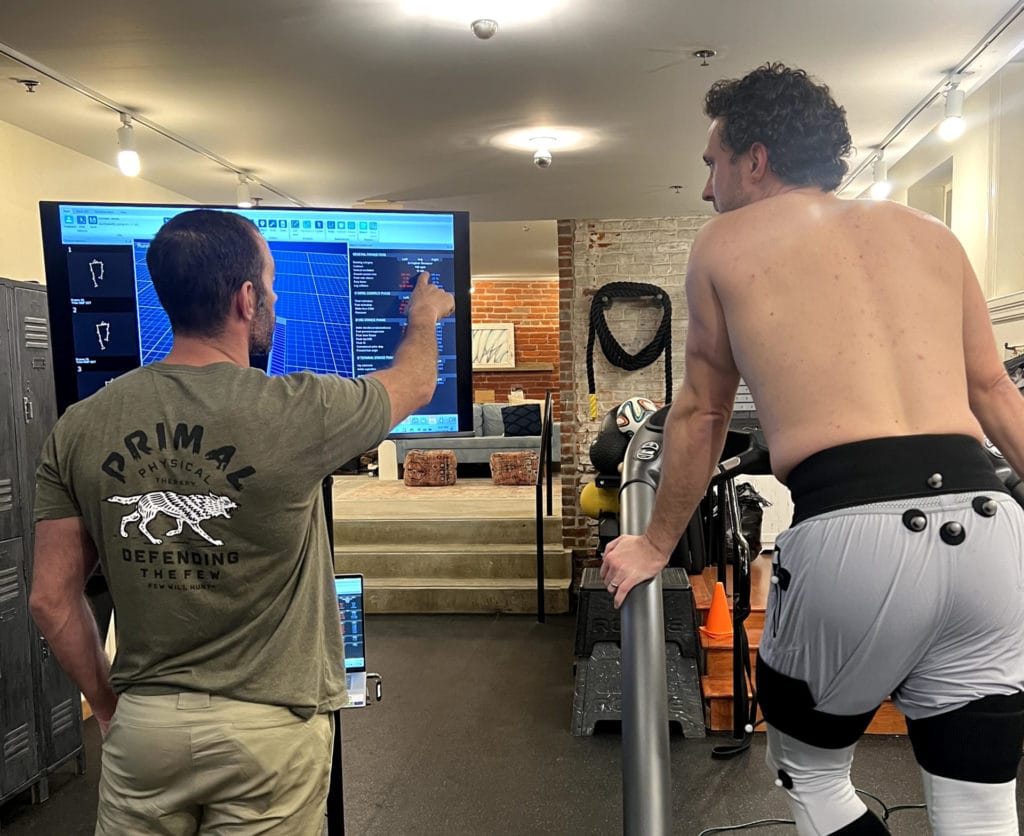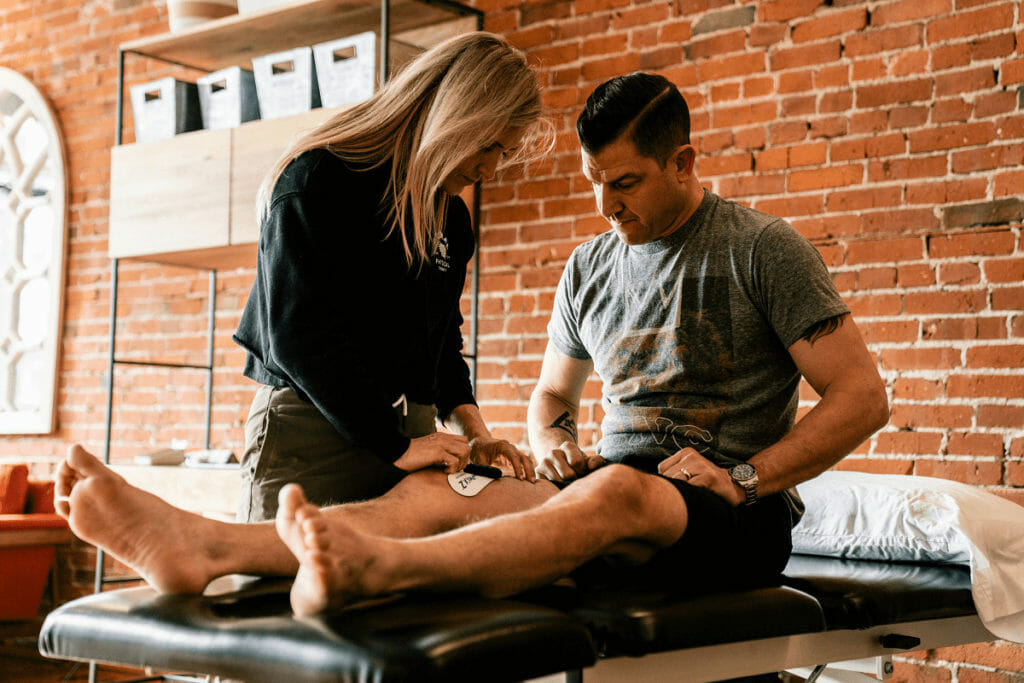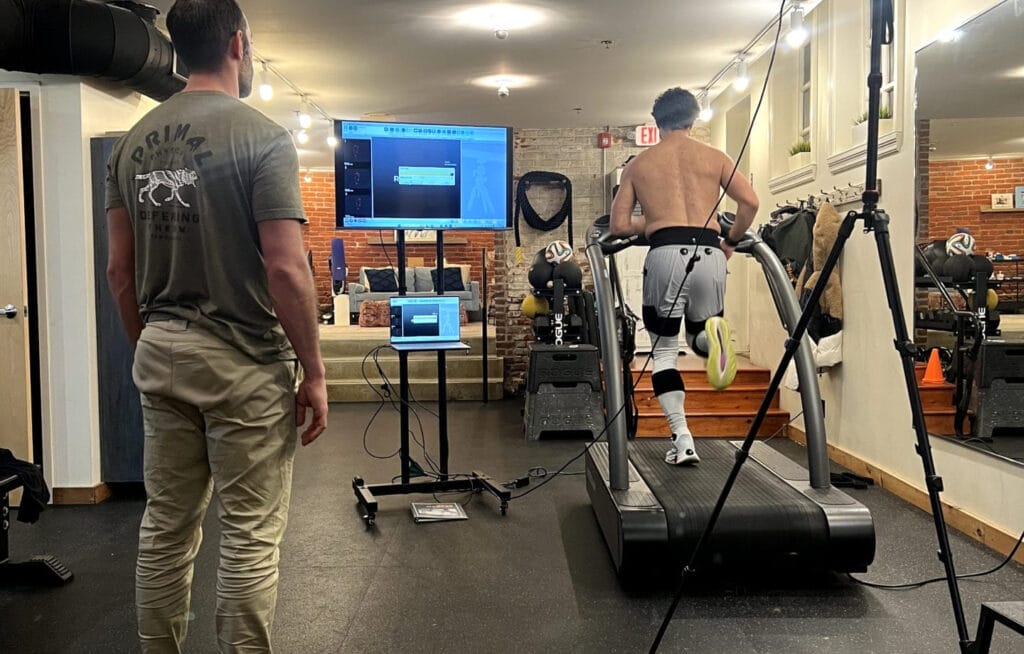Gait analysis is a game-changer for understanding the true sources of your pain and movement patterns. By diving deep into your unique mechanics, this process helps uncover the underlying reasons behind your injuries, postural issues, and even recurring aches. With a personalized approach, gait analysis doesn’t just help you move better—it sets you up to stay active and pain-free for the long run.

What is Gait Analysis?
Gait analysis is a tool we use in addition to an evaluation to more accurately identify the factors contributing to a particular injury, especially when that injury likely has factors causing you to have altered walking or running patterns. It also very accurately helps us connect the dots between deficits in your mobility and/or strength patterns that are causing you to have altered walking or running gait. By taking the data we find on your physical therapy evaluation and comparing it to the details of your gait analysis, we can often have a greater ability to analyze all of the factors related to your pain and injury.
Repetitive stress injuries in activities such as running or walking are often multifactorial, occurring due to flexibility, strength, and stability limitations. Your physical therapist will perform a gait analysis by inspecting all aspects of your gait from head to toe in every phase of the gait cycle and comparing these results to a detailed movement analysis. This will help identify critical limitations in range of motion and/or strength. Finding and correcting your unique limitations will significantly improve your gait and mechanics. This will ultimately help you heal your current injuries, prevent new ones, and even perform better through more efficient movement patterns.
The gait analysis we offer at Primal includes an initial evaluation, even before putting you on the treadmill. During this phase of the analysis, we discuss your history in detail, including your current and previous injuries, your goals, and your timeline for performance if it applies to a current training cycle or a particular goal of yours. After this, we then perform a detailed movement evaluation where we first identify how you move throughout all of the joints in your body. This is important to flag potential flexibility or strength limitations that might be relevant to your injury and the gait deficits we may (or may not) see during your gait analysis.
Many different types of healthcare practitioners use gait analysis in their practices. It is important to realize that different medical professionals will have different goals when it comes to performing and using gait analysis. Some clinicians use gait analysis to study cardiovascular health and heart rate variability. As musculoskeletal specialists, our job is to analyze your movement during the gait cycle, compare that to your current joint and muscle restrictions we found on your evaluation, and make recommendations on how to help you overcome those limitations so that you move better and feel better.
We will often do manual techniques and offer exercise suggestions to give you the best chances of improving your gait without having to think about your gait itself. We will also offer coaching and cues, however, on your gait to improve your efficiency with gait as well. Sometimes, these cues will be related to how you’re landing your foot (striking pattern), and sometimes, we will simply ask you to target a certain cadence, which has been shown in research to be an effective strategy for improving gait in certain instances.

The Relationship Between Gait and Posture
Gait is an innate, fundamental skill that is hard-wired in our DNA. What’s hard for some people to understand is how something that is innate within us can go so “wrong” fundamentally. This happens through years of developing compensations. We develop compensations from things we do repeatedly throughout our days.
For some, the compensations happen because they sit at a desk all day, and although they run and exercise regularly, it’s not enough to combat the body’s tendency to tighten from the cumulative time spent sitting.
For others, it happens because they train hard, but they train hard in the same patterns all of the time. This causes the body to lose the patterns that are outside of the runner’s typical planes (deep squatting, lateral lunge (groin stretch), etc. An example of this would be someone who runs 40 miles per week but only strength trains out of those patterns 45 minutes per week. The body will just start to lose its ability to move outside of the running patterns, and over time, it becomes less and less efficient until it eventually breaks down.
Oftentimes, we can see these tightnesses in posture as well. Runners will often have rounded, tight shoulders, and a forward head position. But what’s really cool about a detailed gait analysis is that while we fix your gait pattern, you’ll see your posture improve, too! The deficits you see in your posture are all part of the compensations you’ve developed over the years and are manifesting into your gait, ultimately predisposing you to injury. We see these effects translate into improvements in everything from your foot mechanics (heel strike, midfoot landing angles, and push-off) to your stride length and ground reaction forces.
So whether you’re interested in running more efficiently, preventing pain in the future, or recovering from an injury right now, you’d benefit from getting a detailed gait analysis. The added bonus is that you’ll experience long-lasting postural changes as we address all of the underlying compensations that contribute to your gait changes.
Common Gait Problems Linked to Pain
Specific things we might look for during the gait analysis include:
- Stride length
- Heel strike pattern
- Crossover patterns
- Overstriding
- Knee drive
- Pelvic drop
- Trunk lean
In addition, we will look at the angle of every joint from your pelvis all the way down to your feet to determine if you’re losing energy through inefficient movements anywhere along the gait cycle. There is tons of data on ideal angles for each joint to be during every phase of the gait cycle. So, we analyze each joint at:
- Heel strike
- Midstance
- Push off
- Swing phase
Analyzing all of these components helps us pick up correlations between typical injuries that relate to certain atypical gait patterns. For instance, overstriding is often a common finding with chronic hamstring tendonitis/tendinopathy. Pelvic Drop is often a common finding with Gluteal tendonitis, ITB syndrome, Patellofemoral Syndrome, Peroneal tendinitis, and more. There are also tons of studies that show how an inefficient heel strike pattern is linked to chronic pesky injuries like shin splints, stress fractures, Posterior Tibialis Tendinitis, and plantar fasciitis. Not to mention, any of these above compensations can turn into lower back pain, hip pain, or knee pain.

Solving the Puzzle: Reducing Pain Through Gait Analysis
When someone comes to us for gait analysis, and they’re currently in pain or have an injury, the gait analysis gives us more data points to confirm our theories and address the many factors that might be related to their injury.
Oftentimes, the reason for the gait deficits comes from a combination of flexibility or strength limitations at a particular joint (or multiple joints), which causes the body to try and compensate. Over time, since these limitations make the body less efficient and effective with gait, those compensations end up breaking down various bones, joints, muscles, or tendons in the process, resulting in pain. We are able to use the detailed movement analysis in combination with the specific data obtained during the gait analysis to provide a clear picture of what caused an area to break down – and what to do to fix it.
Don’t just take my word for it, though. Stuart Ward, 2021 found that if we reduce the stress of each step by 10%, we can run twice as far before our body experiences breakdown. This is an incredibly useful piece of data that shows how small changes can make a big impact.
Who Should Consider Gait Analysis?

Gait analysis is a great idea for anyone who runs for their sport or for life (yes, chasing after or keeping up with your kids counts too). It will help athletes not only recover from injuries faster, but it will also help athletes run more efficiently. This translates into improved performance. It is useful for any athlete of any kind, as being able to improve performance through gait will help you run faster more efficiently and make you more resilient and less susceptible to injury.
Even if you aren’t currently experiencing pain during running but notice that you may have some of the postural deficits we mentioned earlier, it would be a good idea to get a gait analysis BEFORE your body breaks down to the point of injury of pain. The beauty of the gait analysis is that it’s so accurate that we can pick up deficits in movement before the injury happens, give you exercises to improve your efficiency, and prevent you from breaking down in the future. This is something our highest performing athletes choose to do as they begin training for a particular race, or our high school athletes do as they’re trying to get recruited for college. The gait analysis gives them an edge on performance that will give them an advantage when it matters.
For our recreational runners, the choice to do a gait analysis allows them to increase their miles and running and avoid injury and breakdown. Running is an excellent way to manage weight and encourage cardiovascular health, but for those who run recreationally, there are often things they can do to run more efficiently so they don’t break down and get injured.
Ultimately, someone should get a gait analysis if they want to:
- run more efficiently
- perform better
- heal an injury faster
- be able to increase training without getting injured
- Give themselves an advantage over their competitors
- Increase their overall health and longevity
What to Expect During a Gait Analysis
To perform the gait analysis, we will first place reflectors on specific parts of your body so that the 3D camera system can capture the important angles at all of the joints in your lower trunk during each phase of the gait cycle. After a brief warm-up period, we then take a video snapshot of your running gait using the 3D camera system. The computer then generates data using these vectors that we can use to determine how well you’re moving at each phase of the gait cycle.
Your physical therapist will then analyze this data with you and compare this data to the information they found during your baseline evaluation to determine what areas of your gait can or should be improved to help you run more efficiently and heal or prevent pain. You will also spend some time working on cues and minor adjustments while hooked up to the 3D system to determine if there are certain things you can do immediately to improve your gait. The therapist will test this by taking more snapshots of your running gait while they coach you through different cues to help you run more efficiently.
At the end of the first session, you’ll leave with some homework that might involve small things to work on during your training, as well as exercises to help restore the flexibility and/or strength components that are related to your altered gait. We’ll usually schedule a follow-up session as well to make sure the cues and exercises are doing their job and helping you get the most out of your training and our work together.
Step Forward with Confidence and Comfort
Through detailed gait analysis, you can unlock significant improvements in both your movement and posture, paving the way for reduced pain, enhanced performance, and a healthier future. By addressing the root causes of your gait inefficiencies and developing personalized strategies, you can build strength, optimize flexibility, and restore balance, allowing you to walk, run, and move more efficiently. Start with a gait analysis to empower yourself to move comfortably and confidently, one step at a time.